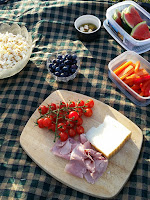Contamination is a top concern for us at the U-M Waste Reduction and Recycling Office (WRRO) and it should be one for you too. Contamination occurs when trash and other things that don’t belong are collected with recyclables and compostables. Plastic bags, glass containers, and light bulbs are just a few of the items considered recycling contaminates at U-M. Anything that’s not food waste, like a coffee cup or plastic fork, is considered a contaminate among compostables.
However, if you attend a Zero Waste Event, the cups, plates, napkins, and cutlery you throw away will all be compostable due to their special design.
Recycling Contamination
U-M sends mixed recyclables to a Materials Recovery Facility. There, the recyclables are sorted, baled, and sold.

Keeping recycling contamination rates low is required in order to:
- Prevent unsafe working conditions for sorters
- Maintain the quality and financial value of our recyclables
- Prevent damage to machinery
What is U-M doing to reduce contamination among recyclables?
The WRRO maintains recycle.umich.edu, a website that provides all the information you need to figure out what you can and can’t recycle at U-M. The WRRO also publishes this blog in addition to posting on social media to spread the word about best recycling practices. Rufus the Recycler is also a diligent figure on campus during fall and winter semesters, educating students about recycling at U-M.
New recycling bin signs are also in development to be standardized across the University. The new signs will make it easier for you to know exactly what you should put in the recycling bin or the trash bin.
Compostables Contamination
U-M sends compostable food waste to WeCare Organics, the private operator of the City of Ann Arbor’s compost center. There, food waste eventually decomposes, becomes compost, and is sold as fertilizer or soil adamant.
 Compostables are not sorted, requiring that all the material we send to WeCare Organics must decompose. This means that U-M must be more strict in its efforts to reduce contamination among compostables than it is with recyclables. After all, you wouldn’t want to find a plastic cup mixed in with the compost you purchased for your garden.
Compostables are not sorted, requiring that all the material we send to WeCare Organics must decompose. This means that U-M must be more strict in its efforts to reduce contamination among compostables than it is with recyclables. After all, you wouldn’t want to find a plastic cup mixed in with the compost you purchased for your garden.
What is U-M doing to reduce food waste contamination?
While we can’t sort through food waste, we can make sure that what we originally put in the compost bin is a compostable. Pre-consumer food waste is collected by trained staff in the prep kitchens of U-M dining halls and catering locations. The East Quad dining hall also processes post-consumer food waste through a pulper, extracting water, before sending it to the Compost Center.
In addition to the standardization of recycling signs, compost signs will be updated and standardized to improve the understanding of what compostables are.
So what can YOU do to reduce contamination among recyclables and compostables?
- Be mindful of what you put into the recycling bin or compost bin.
- Remember, when in doubt, throw it out.
- Take advantage of the resources provided by the WRRO and educate yourself about what is recyclable and compostable at U-M. Visit recycle.umich.edu!















